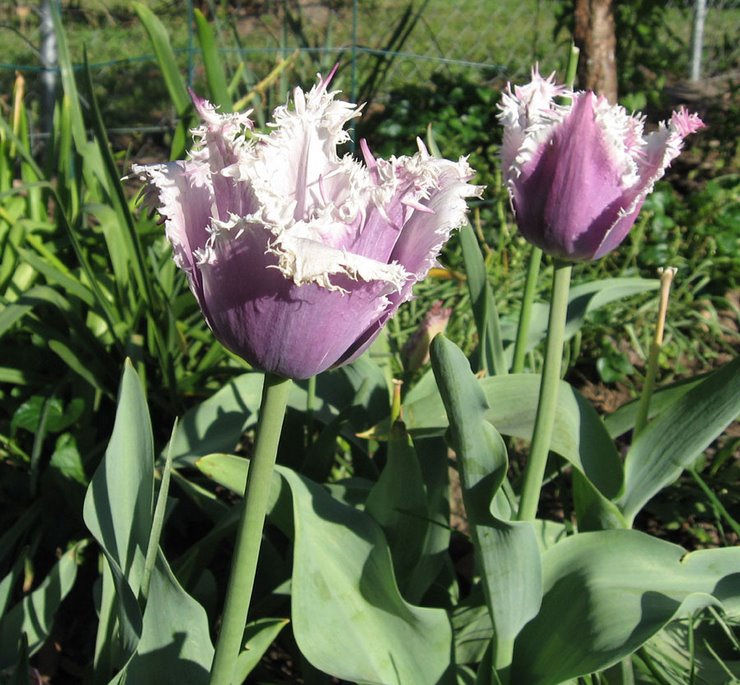 | |
| Peas, marigolds and parsley in late October |
As flowers and vegetable plants die, I remove the dead plants, so they don't harbor insect pests or diseases over the winter. Perennial stems I cut back to ground level. A few things that offer valuable food for local birds, such as coneflowers, I leave until spring. Healthy plant stems and leaves can be shredded or chopped and added to compost, but anything that may have had any disease or pest problems should be put in the trash. I also watch out for any kinds of seeds. If your compost pile doesn't get hot enough, disease organisms, weeds, and seeds may not be killed during the composting process, and you'll just be multiplying these problems.
The compost or other mulch I spread over flower beds at the beginning of the summer has substantially decomposed by now. So it's important to spread new mulch to protect plants and soil over the winter months, and to prevent soil erosion. This will help keep the temperature of the soil even. Once the soil is frozen, that insulating layer will help it stay frozen. This will protect the soil from the shifting and cracking of repeated thawing and freezing cycles that can heave smaller plants and bulbs to the surface.
After removing the dying annuals, and trimming back the dormant perennials, mulch beds with a nice thick layer, 2-4 inches deep, of pine needles or chopped leaves. I usually wait until after the first hard freeze, so that the ground has started to freeze before mulching, so that I don't encourage insect pests to harbor there. To avoid rot or rodent damage to plants, don't pile the mulch up against plant trunks or stems.
Before the first hard freeze, I empty out my rain barrels and either store them in the garage or simply turn them upside down so that water can't accumulate. If water were to freeze in a barrel, the expanding ice would damage it.
As gardening ends for the winter, I clean my garden tools before I put them away for the season. A stiff wire brush is good for this. I avoid washing them with water, as that can lead to rust. Tomato cages and trellises should be cleaned off and stored away. Again, a wire brush can be used to clean off dirt or rust.
Garden hoses need to be removed from the spigot, emptied, and stored in the garage. Any water left in them will cause mold, so I try to empty them out as much as possible. If you have an air compressor, that could be used to dry them out.
I empty out pots and other containers, sterilize them with hot soapy water, and stack them in the garage. Any hardy plants that stay in containers outside over the winter I move to more sheltered locations. You can help protect them further by wrapping the container in bubble wrap, and adding a layer of mulch over the surface.
Non-hardy bulbs, like dahlias, elephant ears, and gladiolas, need to be dug up and taken indoors for the winter. I let them dry for a few hours, then store them in a paper bag with peat moss, and mark each bag with a note of the contents. Keep these bags in a cool, dry place.
I protect my roses by wrapping a circle of chicken wire around their bases, and filling it with leaves to insulate the tender woody plants from extreme cold temperatures. Remove this in the spring. For shrubs and trees, remove diseased leaves, but pruning is not recommended in the fall as it may stimulate new growth just as the harsh winter is coming.
During the fall, I give my pond one last thorough cleaning, removing the fallen leaves and debris, and cover it with a net to keep any additional leaves out. Earlier this fall, I switched to feeding my fish with a fall/winter food, when the temperatures were around 60 degrees. As the fishes' metabolism slowed with cooler temperatures, I feed them less and less, and stop feeding them entirely when the temps are around 50.
A little later, I will remove and clean the pond filter and pump for the winter, and set up the de-icer. It's best not to run the pump over the winter. The fish settle to the bottom of the pond in a hibernation-like state, and depend on the thermal layers of the water to keep warm. Running the pump disrupts those thermal layers, and endangers the fish.
As the first hard frost was forecast for this weekend, I picked all the last tomatoes and peppers and brought them in. I hate to see the end of the gardening season, but I'll also be relieved to be done with all of the preparation for winter I've described above.

2 comments:
WOW
You could very well have a great
column to help beginners (publicized
some way). I'm wondering about some siblings - - might really benefit!
GUESS WHO ? ?
Aw, this was a really nice post. In idea I would like to put in writing like this additionally – taking time and actual effort to make a very good article… but what can I say… I procrastinate alot and by no means seem to get something done.
Post a Comment